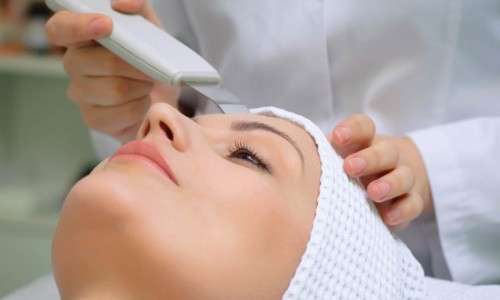- 190 DD CCA, next to Jamia Mosque, DHA Phase 4 Sector CCA Dha Phase 4, Lahore, Punjab 54000, Pakistan
- 03-111-077-111
Microdermabrasion

Microdermabrasion treatments are carried out with a minimally abrasive instrument that gently sands your skin, removing the thicker, uneven outer layer.
Do you ever look in the mirror and wish that your face had a more even skin tone? If you answered yes, you may want to consider microdermabrasion. This non-invasive treatment gently exfoliates your skin. After a series of treatments, your complexion can appear smoother, brighter, and more even in color.
The microdermabrasion that a dermatologist performs differs from the one that you can do at home with a kit. A dermatologist treatment goes a bit deeper into the skin. Still, the procedure is safe for all skin colors.
Microdermabrasion appeals to many patients. They like that they can see more youthful skin without having downtime.
Dermatologists also use microdermabrasion to improve the results gained from using anti-aging products and skin-bleaching products. Microdermabrasion allows these products to penetrate the skin more easily.
This type of skin rejuvenation is used to treat light scarring, discoloration, sun damage, and stretch marks.
Microdermabrasion can:
- Improve age spots and black heads.
- Improve hyper-pigmentation (patches of darkened skin).
- Exfoliate your skin, resulting in a refreshed appearance.
- Lessen the appearance of stretch marks.
- Reduce fine lines and wrinkles.
- Reduce or eliminate enlarged pores.
- Treat acne and the scars left by acne.
Microdermabrasion helps to thicken your collagen, which results in a younger looking complexion.
Collagen:
Collagen is a protein in your skin that’s abundant when you’re a child and makes skin appear taut and smooth. Collagen production declines as we age, resulting in looser, uneven skin.
Warning: Although microdermabrasion is a gentle, non-invasive treatment, you should see a dermatologist before getting this treatment at a spa or using an at-home microdermabrasion kit if you:
- Have a mole or other spot on your skin that is growing, bleeding, or changing in any way. This spot could be a skin cancer.
- Are taking (or have taken) the acne medicine, isotretinoin, which is prescribed to treat severe acne. If you have taken this medicine within the past 6 months, you have a higher risk for complications, including scarring. You may need to wait before having microdermabrasion.
- Scar easily.
The Basics
Microdermabrasion is a general term for the application of tiny rough grains to buff away the surface layer of skin. It’s usually done to the face, chest, neck, arms or hands. Before we can understand how microdermabrasion works, it’s important to understand how skin works.
Your skin is made up of two main layers, the epidermis and the dermis. The epidermis is the layer closest to the outside world. It’s a set of dead skin cells on top of another layer of cells that are in the process of maturing. The topmost layer is called the stratum corneum. The stratum corneum mostly acts as a barrier between the outside world and the lower skin layers. It keeps all but the smallest molecules from getting through.
When you put lotions or creams on your skin, some of the moisture passes through the stratum corneum, but not all of it. This layer is home to many minor skin imperfections like fine wrinkle lines and blemishes.
All of the action in microdermabrasion takes place at the level of the stratum corneum. Since it only targets the epidermis (and not the dermis), it is more accurate to call it micro-epi-dermabrasion.
Procedure:
Microdermabrasion uses tiny exfoliating crystals (Aluminium oxide) that are sprayed on the skin. It works best on problems such as dull skin, brown spots, and age spots.
The dermatologist uses a handheld device that gently removes the top layer of skin. You may feel a sanding sensation, but this is not painful. It takes about 30 to 40 minutes to treat the entire face and about 20 minutes to treat the neck.
After the treatment, a moisturizer is applied.
Microdermabrasion results
Your polished new look should be long-lasting, depending on the severity of your skin damage and the number of treatments that you receive.
Many people have two microdermabrasion treatments per month at first and then one per month as part of a maintenance plan.
Most patients need a series of treatments to see results. To treat signs of aging, a dermatologist may treat a patient weekly, every two weeks, or monthly. Most patients receive between 5 and 16 treatments.
After a series of treatments, patients usually say they have smoother skin and a more-radiant complexion.
What will you need to do after microdermabrasion?
You may need to apply a moisturizer or other skin care product at home.
You will be given a skin-care plan that includes sun protection. Protecting your skin from the sun helps ensure the best possible results and reduces the risk of side effects.
Downtime?
You will not have downtime or a recovery period. Some patients’ skin turns pink or red. The skin can swell a bit. These side effects are similar to having a sunburn or windburn for a day or two. During this time, some patients might feel uncomfortable returning to work or being in public.
When can I safely get another treatment?
Microdermabrasion treats only the top layer of the skin, so the skin recovers quickly. Most people can safely have another treatment a week later. Some patients, however, need several weeks to recover.
Safety record for microdermabrasion?
When performed by a dermatologist, microdermabrasion has an excellent safety record.
Microdermabrasion also is performed in salons and non-medical spas. You can reduce your risk for side effects by having microdermabrasion performed by a dermatologist.
Choose a surgeon you can trust
Plastic surgery and other skin treatment involves many choices. The first and most important is selecting a member of the American Society of Plastic Surgeons (ASPS) surgeon you can trust.
- ASPS member surgeons meet rigorous standards:
- Board certification by the American Board of Plastic Surgery® (ABPS) or in Canada by The Royal College of Physicians and Surgeons of Canada®
- Complete at least six years of surgical training following medical school with a minimum of three years of plastic surgery residency training
- Pass comprehensive oral and written exams
- Graduate from an accredited medical school
- Complete continuing medical education, including patient safety, each year
- Perform surgery in accredited, state-licensed, or Medicare-certified surgical facilities
